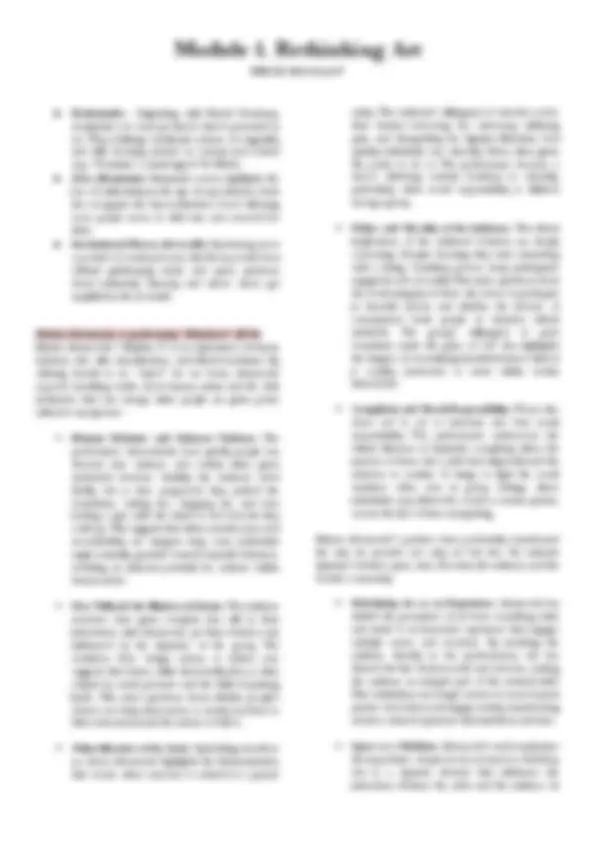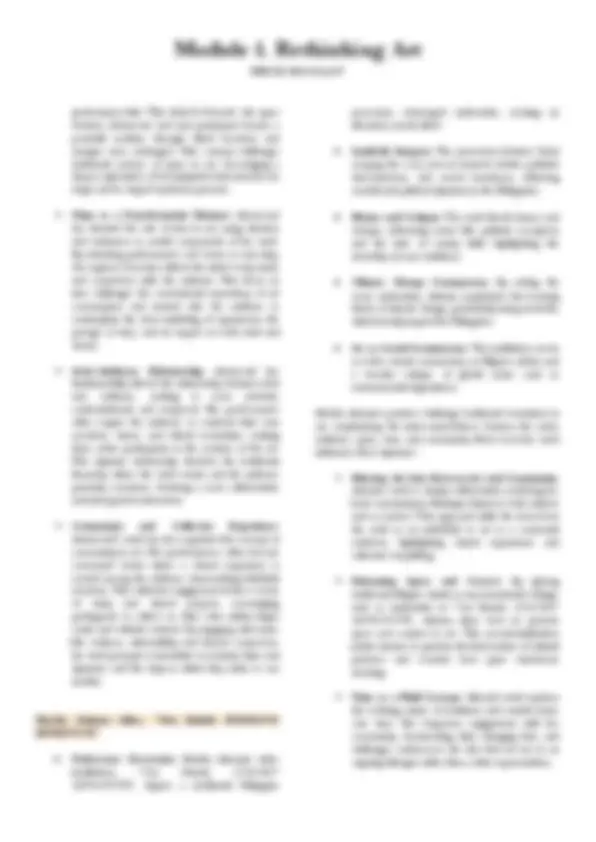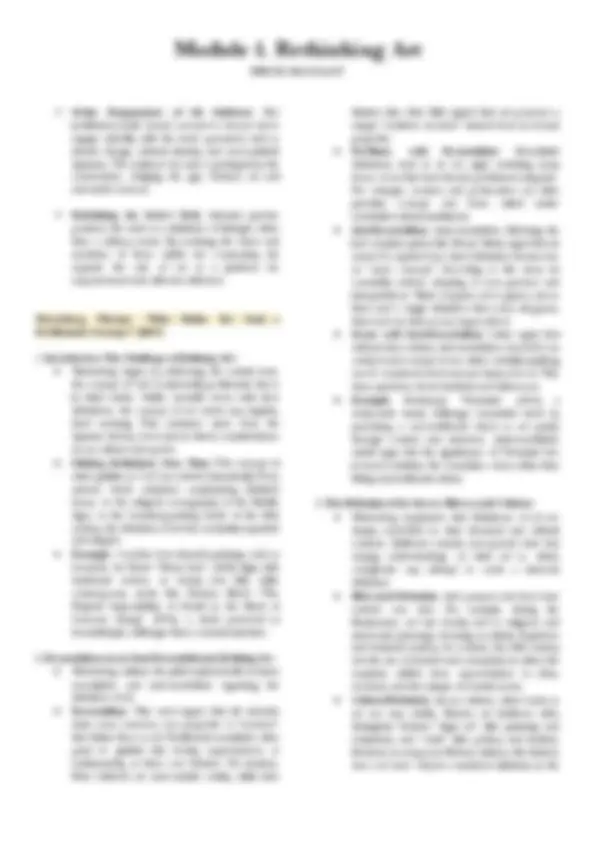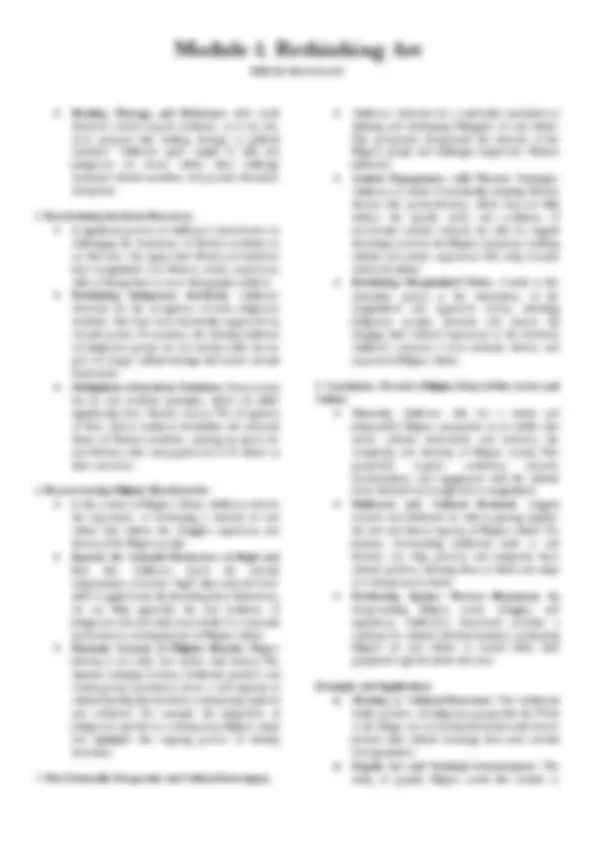







Study with the several resources on Docsity

Earn points by helping other students or get them with a premium plan


Prepare for your exams
Study with the several resources on Docsity

Earn points to download
Earn points by helping other students or get them with a premium plan
Community
Ask the community for help and clear up your study doubts
Discover the best universities in your country according to Docsity users
Free resources
Download our free guides on studying techniques, anxiety management strategies, and thesis advice from Docsity tutors
A comprehensive analysis of art theory, exploring various perspectives on what constitutes art, its social roles, and its cultural significance. It examines key thinkers like plato, aristotle, kant, walter benjamin, and arnold hauser, highlighting their contributions to understanding the evolving nature of art. The document also delves into institutional theories, emphasizing the role of social institutions in shaping artistic definitions and practices. It further explores the concept of art as an experience, challenging traditional notions of space and perception. The document concludes by emphasizing the importance of a critical and independent filipino perspective in art studies, advocating for cultural self-determination and challenging western hegemony.
Typology: Study notes
1 / 9

This page cannot be seen from the preview
Don't miss anything!






EBRON, Mark David F. Overview : The module challenges traditional definitions of art and invites critical reflection on what qualifies something as art, who determines this, and how cultural, historical, and social factors play a role. It also encourages analyzing the shifting boundaries between art and other fields, questioning fixed categorizations.
EBRON, Mark David F. ● Walter Benjamin’s “The Work of Art in the Age of Mechanical Reproduction” : Explores how mass production (e.g., photography, film) erodes the “aura” of unique, hand-crafted art. Traditional art has an aura tied to its authenticity, history, and ritual context, which is lost when reproduced. ● Art as Language (Arnold Hauser) : Challenges the idea that art must be original. He argues that art, like language, is inherently intertextual—each work builds on previous expressions. This counters the modernist obsession with originality by valuing connection and evolution within artistic traditions.
EBRON, Mark David F. performances like “The Artist Is Present”, the space between Abramović and each participant became a powerful medium through which emotions and energies were exchanged. This concept challenges traditional notions of space in art, encouraging a deeper exploration of how physical environments can shape and be shaped by human presence. ➢ Time as a Transformative Element : Abramović has elevated the role of time in art, using duration and endurance as central components of her work. By extending performances over hours or even days, she explores how time affects the artist’s body, mind, and connection with the audience. This focus on time challenges the conventional immediacy of art consumption and instead asks the audience to contemplate the slow unfolding of experiences, the passage of time, and its impact on both artist and viewer. ➢ Artist-Audience Relationship : Abramović has fundamentally altered the relationship between artist and audience, making it more intimate, confrontational, and reciprocal. Her performances often require the audience to confront their own emotions, biases, and ethical boundaries, making them active participants in the creation of the art. This dynamic relationship dissolves the traditional hierarchy where the artist creates and the audience passively consumes, fostering a more collaborative and introspective interaction. ➢ Community and Collective Experience : Abramović’s work has also expanded the concept of community in art. Her performances often become communal events where a shared experience is created among the audience, transcending individual reactions. This collective engagement fosters a sense of unity and shared purpose, encouraging participants to reflect on their roles within larger social and cultural contexts. By engaging with issues like violence, vulnerability, and human connection, her work prompts communities to examine their own dynamics and the ways in which they relate to one another. Martha Atienza video, "Our Islands 11°16’58.4”N 123°45’07.0”E" ● Underwater Procession : Martha Atienza’s video installation, “Our Islands, 11°1658.4" 123°4507.0"E”, depicts a traditional Philippine procession submerged underwater, creating an alienated, surreal effect. ● Symbolic Imagery : The procession features Christ carrying the cross, men in women’s clothes, political demonstrators, and armed henchmen, reflecting societal and political dynamics in the Philippines. ● Humor and Critique : The work blends humor and critique, addressing issues like political corruption and the state of society while highlighting the absurdity of some traditions. ● Climate Change Commentary : By setting the scene underwater, Atienza emphasizes the looming threat of climate change, particularly rising sea levels, which heavily impact the Philippines. ● Art as Social Commentary : The installation serves as both a visual commentary on Filipino culture and a broader critique of global issues such as environmental degradation. Martha Atienza’s practices challenge traditional boundaries in art, emphasizing the interconnectedness between the artist, audience, space, time, and community. Here’s how her work influences these dynamics: ➢ Blurring the Line Between Art and Community : Atienza’s work is deeply collaborative, involving her local community in Bantayan Island as both subjects and co-creators. This approach shifts the focus from the artist as an individual to art as a communal endeavor, highlighting shared experiences and collective storytelling. ➢ Reframing Space and Context : By placing traditional Filipino rituals in unconventional settings, such as underwater in “Our Islands, 11°1658.4" 123°4507.0"E”, Atienza alters how we perceive space and context in art. This recontextualization invites viewers to question the fixed nature of cultural practices and consider how space transforms meaning. ➢ Time as a Fluid Concept : Atienza’s work captures the evolving nature of traditions and societal issues over time. Her long-term engagement with her community, documenting their changing lives and challenges, underscores the idea that art can be an ongoing dialogue rather than a static representation.
EBRON, Mark David F. ➢ Active Engagement of the Audience : Her installations invite viewers not just to observe but to engage critically with the issues presented, such as climate change, cultural identity, and socio-political dynamics. The audience becomes a participant in the conversation, bridging the gap between art and real-world concerns. ➢ Redefining the Artist’s Role : Atienza’s practice positions the artist as a facilitator of dialogue rather than a solitary creator. By centering the voices and narratives of those within her community, she expands the role of art as a platform for empowerment and collective reflection. Wartenberg, Thomas. “What Makes ‘Art’ Such a Problematic Concept?” (2007)
EBRON, Mark David F. the art world. These digital assets challenge traditional notions of art ownership and authenticity, illustrating how technology continuously redefines what art can be.
EBRON, Mark David F. ● Healing, Therapy, and Resistance : Art’s social functions extend beyond aesthetics, as it can also serve purposes like healing, therapy, or political resistance. Guillermo gives weight to folk and indigenous art forms, which often challenge dominant cultural narratives and provide alternative viewpoints.